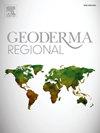Modeling the effect of land use and manure management on soil carbon sequestration in tropical mixed crop-livestock systems: A case study in Guadeloupe (Caribbean)
IF 3.1
2区 农林科学
Q2 SOIL SCIENCE
引用次数: 0
Abstract
In tropical regions, mixed crop-livestock systems (MCLS) afford opportunities to achieve sustainable agriculture by supplying several ecosystem services, including soil C sequestration. The aim of this study was to assess soil C sequestration in representative tropical (Caribbean) MCLS in the Guadeloupe Archipelago. We designed a modeling approach at the scale of the farm and cropping system, based on a data-driven model of soil organic C (SOC) balance coupled to three databases. The variables included soil properties, manure properties (fresh and stored-composted), and farm characteristics of the eight MCLS. The results indicated that land use (i.e., relative area occupied by perennial crops) was the main factor controlling soil C sequestration at the farm scale and that pasture and sugarcane systems were crucial for maintaining or increasing SOC stocks. Under the current MCLS management, only 16 % of manure production is used to fertilize croplands. This mode of fertilization was found to be ineffective at the farm scale, given that it resulted in low (average + 0.03 % yr−1) or negative (up to −0.3 % yr−1) soil C sequestration; manure C inputs did not compensate for SOC outputs by mineralization in annual systems. It is estimated that increasing manure use to near 100 % would increase the level of soil C sequestration 3.5-fold (average + 0.11 % yr−1) and could compensate for up to 20 % of the reduction in C inputs from crop residues used as animal feed. These effects were 50 % higher for fresh manure than for stored-composted manure because of mass and C losses during storage, which reduced the level of manure C inputs to the soil. Overall, the results indicate that increasing manure use and shortening the storage period through, for example, more frequent split applications would be suitable to boost soil C sequestration and sustainability in tropical MCLS by decreasing soil C losses and increasing C retention in soil. However, trade-offs must be made between managing the frequency of applications, the cost and degree of manual labor required, and optimizing the overall health of the MCLS.
模拟热带作物-牲畜混合系统中土地利用和粪肥管理对土壤固碳的影响:以瓜德罗普岛(加勒比)为例
在热带地区,混合作物-牲畜系统(MCLS)通过提供包括土壤碳封存在内的几种生态系统服务,为实现可持续农业提供了机会。本研究的目的是评估瓜德罗普群岛具有代表性的热带(加勒比)mcs的土壤碳封存。基于数据驱动的土壤有机碳(SOC)平衡模型,结合三个数据库,设计了一种基于农场和种植系统尺度的建模方法。变量包括土壤性质、粪便性质(新鲜和储存堆肥)和8个MCLS的农场特征。结果表明,土地利用(即多年生作物占有的相对面积)是控制农田土壤碳固存的主要因素,而牧场和甘蔗系统对维持或增加土壤有机碳储量至关重要。在目前的mcs管理下,只有16%的粪肥用于农田施肥。这种施肥方式在农场规模上被发现是无效的,因为它导致低(平均+ 0.03%年- 1)或负(高达- 0.3%年- 1)土壤碳固存;粪肥C的投入不能通过矿化补偿年度系统的有机碳输出。据估计,将肥料的使用增加到接近100%,将使土壤碳固存水平增加3.5倍(平均每年+ 0.11%),并可以补偿作为动物饲料的作物残留物所减少的高达20%的碳输入。由于贮存过程中质量和碳的损失,这些影响对新鲜粪肥的影响比储存堆肥粪肥的影响高50%,这降低了土壤中粪肥碳的输入水平。总体而言,研究结果表明,通过增加肥料使用量和缩短贮存期,例如通过更频繁的分开施用,可以通过减少土壤C损失和增加土壤中C的保留来促进热带mcs土壤C的固存和可持续性。但是,必须在管理应用程序的频率、所需体力劳动的成本和程度以及优化MCLS的整体运行状况之间进行权衡。
本文章由计算机程序翻译,如有差异,请以英文原文为准。
求助全文
约1分钟内获得全文
求助全文
来源期刊

Geoderma Regional
Agricultural and Biological Sciences-Soil Science
CiteScore
6.10
自引率
7.30%
发文量
122
审稿时长
76 days
期刊介绍:
Global issues require studies and solutions on national and regional levels. Geoderma Regional focuses on studies that increase understanding and advance our scientific knowledge of soils in all regions of the world. The journal embraces every aspect of soil science and welcomes reviews of regional progress.
 求助内容:
求助内容: 应助结果提醒方式:
应助结果提醒方式:


